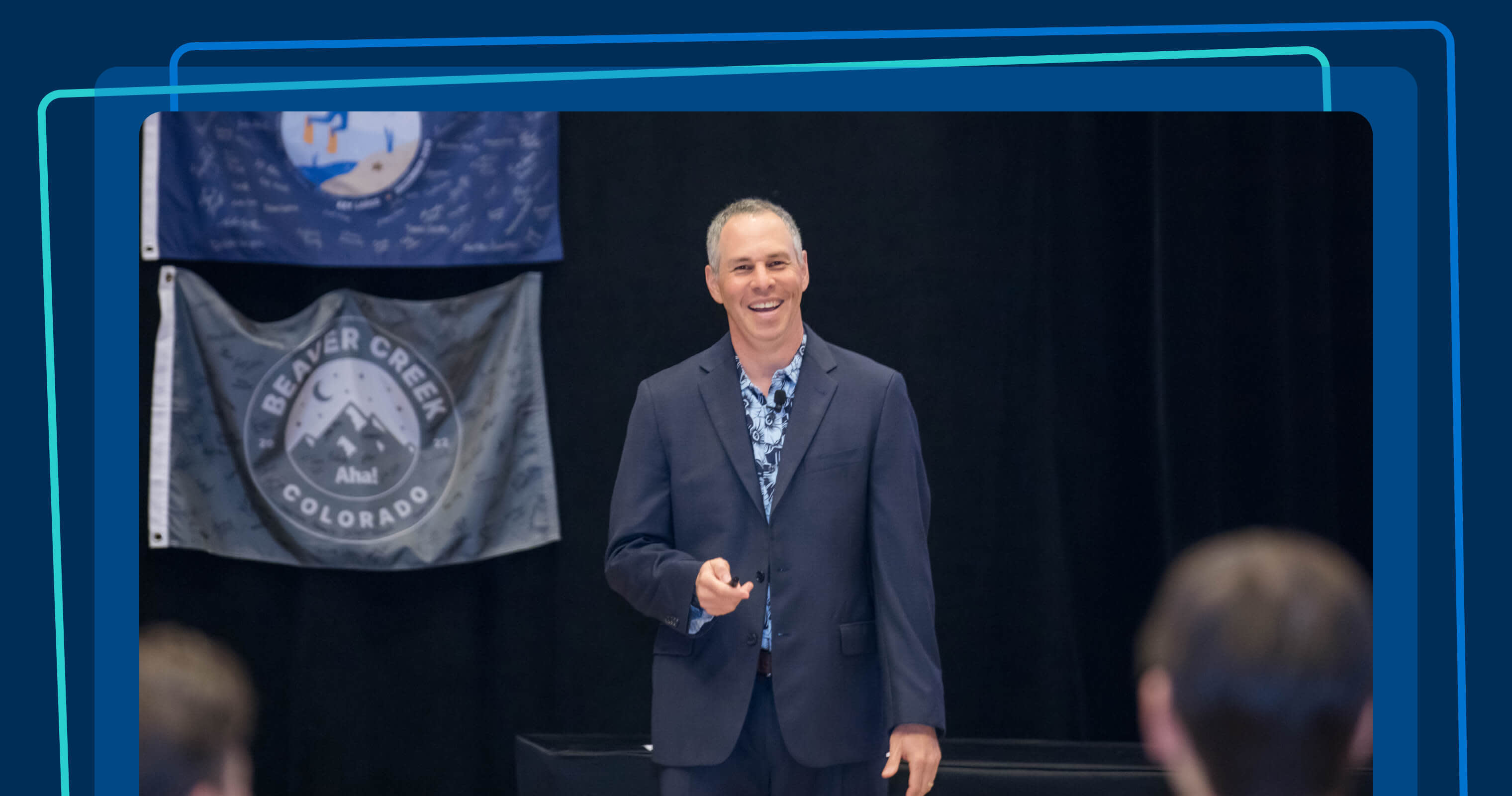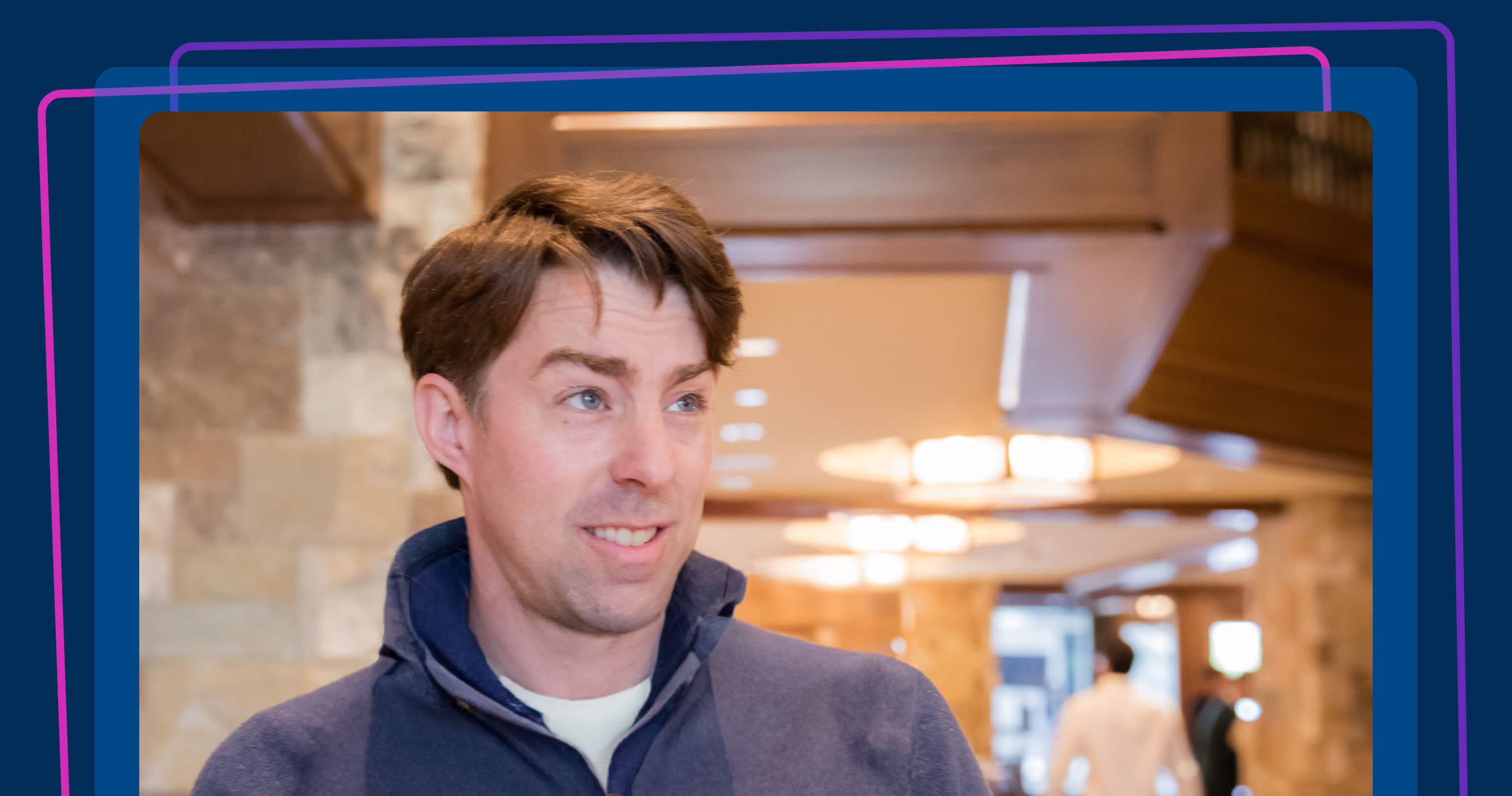
Brian de Haaff giving a presentation to the company at an Aha! onsite | Photo by Jodi B Photography
Stop apologizing and start presenting with confidence
They started to cry at a company meeting. We were doing informal presentation prep with nobody in the audience. This was a few years ago at an Aha! company onsite, and one of our team leads — someone who was gregarious and could easily establish rapport with almost anyone — was just crashing out on an empty stage. I was surprised, but not completely; fear had stolen their voice.
Many folks struggle with public speaking — it is incredibly common. But the problem is that most of us have to do it all the time at work.
The panic sets in before they even start speaking. It arrives in the form of doubt that all of us have felt. So what ends up happening is that folks spiral. They start breathing quickly and looking for ways to couch what people can expect. Instead of a warm introduction or jumping right into a story to pull in the audience, you get a list of caveats as to why the presentation will not be enjoyable, memorable, and maybe not even very good.
No one wants to hear excuses like, "I got started on this late" or "I am not really an expert." These are cop-outs that disrespect your audience before you even begin. If you agreed to present, you owe it to everyone in the room to show up fully prepared and engaged — fear or no fear.
Every time you present, you are spending your own time and consuming other people's time as well. That is a responsibility and an honor.
Recently, I gave a presentation about giving presentations (meta, I know) to the Aha! team ahead of our next onsite. We spend time every year as a company working on various skills. I shared what I have learned over the years.
One of my biggest tips is to nail the intro. If you know what your intro is and feel confident in what you will say, you buy yourself those first few minutes of comfort and relaxation. You allow yourself to settle in, which gives you agency over the conversation's direction.
Here are the rest of my best presentation tips:
Own the space
It is always a practice for me to see the space before I present in it. I walk around, see where the projectors are, and think about where I should not stand. (Do not stand in front of a projector; if you will be wearing a mic, avoid getting close to the speakers and triggering screechy feedback.) The goal is to feel comfortable in your surroundings so you can be authentically you at presentation time.
The same is true for virtual meetings. At Aha! we have tried to set policies from the beginning to make our spaces feel as authentic as possible. On Zoom, we really do not like the team using those phony backgrounds where you are sitting on a yacht with the beautiful Pacific in the background. We want us to be us — part of that is being honest about the space we are in.
How to own the space:
Preview in-person spaces.
Do a practice run.
Avoid phony Zoom backgrounds.
Speak from your stomach
If you go to a public speaking class, the first thing they will have you do is scream. Not because of how scary public speaking is (although it might help). The idea is to show you how even when we are trying to project our voices as loudly as possible, most of us speak from our throats and not from deep in the gut.
When we get nervous, we tend to stiffen and hold our bodies tightly. The result is a quiet, whispery voice. And to deliver a great presentation, people have to hear what you say — you need to project. You can try screaming at home, but your neighbors might complain. A better approach is to practice diaphragmatic breathing. Put one hand on your stomach and the other on your chest; breathe deep into your stomach and lungs, then say a word loudly as you exhale.
How to project your voice:
Practice diaphragmatic breathing.
Avoid tensing your shoulders, chest, and jaw.
Speak as you exhale and enunciate slowly.
Bring the energy
Your energy is going to drive your audience's energy. I can guarantee that if you have low energy, every single person sitting in that room is going to have lower energy than you do.
It is your responsibility throughout your presentation to explain to people why you are passionate about whatever you are telling them. If you are not passionate about it, you should probably be asking yourself why you are presenting to a large group of people in the first place.
And here is one way we kill energy at the beginning of a presentation: We apologize before we even start. When you apologize, your audience is thinking, "Why am I here listening to you?"
How to bring the energy:
Be passionate about your topic.
Reframe nerves as excitement.
Do not apologize.
Look at people
I can read that screen myself. I want to see your face. People should not be looking at your back. When you present, you should be presenting to an individual. You should be squaring them up and talking directly to them. Now, if that is too hard — if it is too uncomfortable and you do not feel like you are there yet — start out by focusing on an inanimate object while you get your bearings.
Move your gaze around the room. Pick one person to make eye contact with while you make a point or complete a concept, then move on to the next one. Pick out folks from the front to the back to ensure you are connecting with the entire audience. If you are on a Zoom call, look at the camera instead of at the screen.
How to connect with the audience:
Scan the room randomly.
Make eye contact and hold it.
Try to smile.
Keep slides succinct
How do I know which point is the most important if you go through all five or six? I am exhausted by the time you get to your fourth slide. This is probably the thing that presenters do wrong more than anything else.
One, two, or three points per slide — no more. And please, do not read the bullet points. Unless you really need to emphasize something and repeat what is on the screen verbatim, paraphrase.
How to keep slides succinct:
Include no more than two to three bullets.
Paraphrase key points.
Do not read your bullets verbatim.
Tell stories
What do people really remember about presentations? The stories. In a group of 20+ people, not every story is going to hit with everyone. What you are looking for is connection with at least a few.
Telling stories is really hard. Telling stories that relate to your material is even harder. This is a "practice, practice, practice" type of thing. Try different approaches knowing that some stories will work and some will not. There will always be a next time.
How to tell stories:
Start with a clear structure (beginning, middle, and end).
Make it personal.
Use descriptive language.
Manage your time
When we are running late, we naturally start rapid-fire speaking so fast that nobody can understand. Does the audience know we had 70 slides? No. Do they care? Probably not. Can we skip a few if we need to? Of course.
I recently spoke with a friend who was lamenting that they ran out of time presenting and just started rushing to get through. They noticed that the audience drifted further and further as they went faster and faster.
You need to know roughly how long it will take to get through something. And you need to monitor yourself in real time. That is hard. You need to have your own internal clock going. A watch or timer helps too.
How to manage your time:
Plan to deliver in less time than allotted.
Rehearse with a timer.
Prioritize the most important content.
Close with purpose
Most of us do not even think about our presentation exit because we are so thrilled to have simply survived presenting to a group of people. This is the one I constantly remind myself to practice and plan ahead for. How do you wrap up what you shared? How do you get off the stage?
It seems like the simplest thing, but it is not. It can be awkward. So think ahead about how you stop and when you want to stop. Do you want to surprise with: "You thought that was it, but I have got one more thing for you"? Thinking ahead about the intro and the outro is a good way to approach it.
How to close with purpose:
Know your intro and ending.
Have a call to action.
Thank the audience.
Great presentation skills are not a natural talent — you develop them through preparation and practice.
The best presenters do not just share information. They create an experience. They tell stories. They look people in the eye and make them believe that what they are saying matters. The same skills apply to the presentations you give at work and the ones you make for friends and family. (I was just at my cousin's wedding, and all of the tips above apply to toasts as well.)
Start with the mindset of, "I am going to honor the time and attention these people are giving me by showing up fully prepared and fully present." Remember that you are spending your time and everyone else's. Make it worth it. It is your opportunity to educate and energize and feel great about it.
Craft the perfect presentation try our presentation slides template (built by experts).




